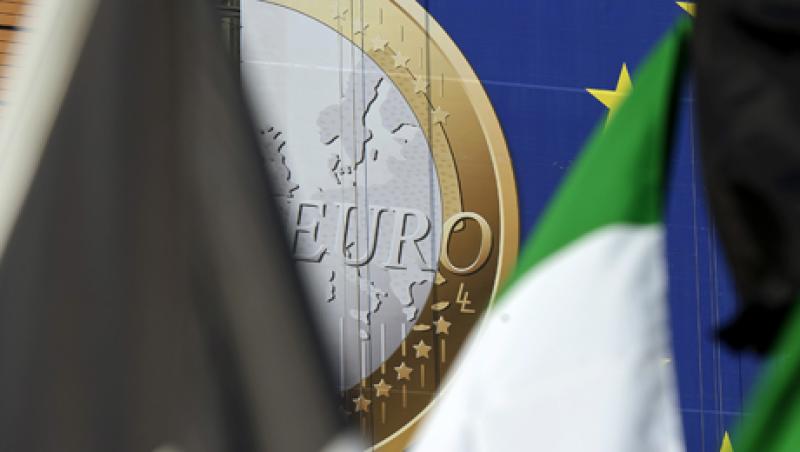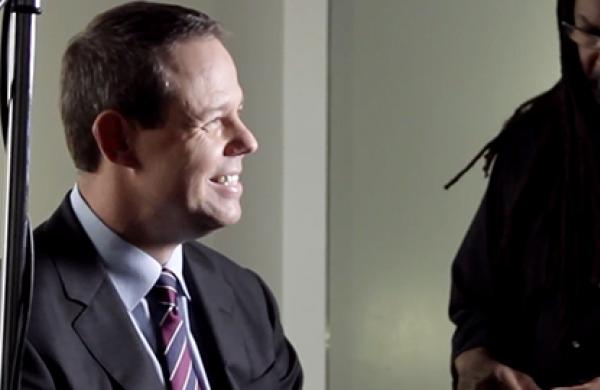Diminished expectations. For a baby boom generation raised on the belief that tomorrow will always be bigger and better, the idea of lowering one’s sights is a bitter pill to swallow. Yet four-plus years after the crisis, many are having to do just that, making the prospect of reduced expectations a central theme of the U.S. presidential election and the continuing debate over the austerity policies that European governments have adopted.
For European money managers, diminished expectations are a daily challenge. Now that the European Central Bank has joined the Federal Reserve Board as a willing bond buyer of last resort, interest rates appear set to remain at historically low levels for the foreseeable future. The debt crisis has plunged a large part of the euro area into recession and slowed growth in core countries like Germany and France to a near standstill. Hopes for a lift from abroad have faded because of worries over the year-end “fiscal cliff” in the U.S. and a deceleration of growth in emerging markets.
“People are coming around to accepting that there is no massive global growth engine,” says Kerrigan Procter, head of the liability-driven investment solutions group at Legal & General Investment Management, the fund management arm of the U.K. insurer.
For firms that are paid to preserve and grow capital, today’s environment is daunting. The fear of another 2008-style collapse may have receded, but the odds of a bounce à la 2009 seem even more remote. Investors continue to diversify in a search for yield, notably into emerging-markets debt, but they want their managers to keep a very close watch on risk.
“We may be in a great big flat phase where markets don’t go anywhere, and direction changes between risk-on and risk-off on a regular basis,” says Hendrik du Toit, CEO of Investec Asset Management in London. “It’s very difficult to generate consistent alpha.”
Every challenge brings an equal measure of opportunity, though. Managers cite a growing trend toward unconstrained mandates from investors eager to boost returns. This is an ideal time to gain market share for managers that can perform well in difficult conditions.
“In these volatile markets active managers should have an advantage because they can play the markets tactically,” says Asoka Wöhrmann, co-CIO of asset management at Deutsche Bank’s recently reorganized Asset & Wealth Management division. Deutsche renewed its commitment to the business after failing to conclude a sale of its asset management arm to Guggenheim Partners earlier this year. “There is a core conviction for stable businesses like asset and wealth management,” Wöhrmann says. “We want to catch up to the top managers.”
Deutsche is certainly within striking distance, according to the 2012 Euro 100, Institutional Investor’s latest ranking of the region’s largest fund managers. The German bank stands in sixth place on the list.
There are no changes at the top of the ranking as German insurer Allianz Group returns in the No. 1 position, with €1.9 trillion ($2.5 trillion) in assets as of June 30, followed by France’s AXA, Swiss bank UBS, France’s Amundi and New York–based BlackRock. Total assets of the 100 top firms stood at €18.6 trillion at the end of June, up €1.1 trillion, or 6.29 percent, from a year earlier.
For many investors in Europe, as elsewhere, income is increasingly king because it is so scarce. Good yields can be as hard to come by these days as a full tank of gasoline in the New York area after the passing of Hurricane Sandy. The obsession with yield is particularly acute because many investors remain leery of equities.
The Euro Stoxx 50 Index plunged 30 percent during the summer of 2011 when fears of a euro breakup intensified; since then it has traded in a fairly narrow range of roughly plus or minus 10 percent.
Investors are looking for return in the form of income rather than price appreciation because market volatility has made them distrustful of so many asset values, says Michael O’Brien, London-based global head of the institutional client group at J.P. Morgan Asset Management. With rates so low on most Western government and corporate bonds, many investors continue to turn to higher-yielding emerging markets to generate income, he adds. J.P. Morgan analysts estimate that global flows to emerging-markets fixed-income securities hit $67 billion between January and September and were on pace this year to exceed the record of $80 billion set in 2010. It’s not hard to see why. The JPMorgan EMBI Global Diversified Index, a benchmark for the sector, posted a return of 15.2 percent in the first ten months of 2012.
Investec has focused heavily on emerging markets since it was founded in South Africa in 1991. It currently has more than 50 percent of its roughly $100 billion in overall assets invested in those markets, says chief executive du Toit. Assets denominated in local currencies are showing the fastest growth, reaching more than $20 billion, he notes.
“We try to position for this huge trend of a world that normalizes as the world of 250 years ago, when the largest economy was in Asia” and no single economy dominated the globe, explains du Toit. “We think that’s the game for an active manager.”
Although investors are sending more capital abroad, most European investors continue to put the bulk of their money to work closer to home. In the U.K., where ten-year government bonds yield just under 2 percent and the equity risk premium is running at 3 to 4 percent, generating the kind of income that pension funds and insurers require to meet their liabilities is getting harder.
“If you’re looking for returns of more than 5 to 6 percent, you’re going to have to take on some leverage or do some pretty aggressive risk-taking,” says Legal & General’s Procter. For most investors, he adds, the big question today is, “How can you eke out returns in a very risk-controlled manner?”
Many money managers are finding the answer in less-liquid markets. Legal & General runs a £30 billion ($48 billion) annuity book and has been plowing more money into commercial loans and property sale-leaseback deals in an effort to juice up returns, according to Procter. “We’d love to roll that out to external clients,” he says.
Pension funds in particular are hungry for longer-dated investments that offer higher returns in exchange for reduced liquidity, says J.P. Morgan’s O’Brien. “Pension funds are looking at infrastructure debt, loans and mezzanine” securities, he maintains. PensionDanmark, a Danish pension fund with €16 billion in assets, hired J.P. Morgan in June to source up to €750 million in infrastructure loans for its portfolio.
The search for yield has even prompted some renewed interest in the ultimate illiquid market — government debt of peripheral euro area countries. Recent steps by the region’s authorities, including the European Central Bank’s announcement of Outright Monetary Transactions to buy bonds of troubled countries and the launch last month of the new €500 billion European Stability Mechanism bailout facility, have persuaded some investors that Europe is finally addressing the root of its problems and triggered a major decline in yields on Spanish and Italian bonds, among others.
“We reentered the periphery in the summer,” says Roderick Munsters, CEO of Robeco Group, the Dutch fund manager. “If you look at the rally in euro peripheral bonds, it’s been huge.” Still, the amount of real money going into Spanish and Italian debt, much less Irish, Portuguese or Greek, remains modest. As J.P. Morgan’s O’Brien puts it, “We would prefer the currency risk of emerging-markets debt to the credit risk of peripheral countries.”
Developed-markets equities remain largely out of favor as investors worry about the growth outlook in the West and continue to boost allocations to emerging markets. Investors remain scarred by the sharp drops in equities during the technology crash at the start of the 2000s and again during the 2008–’09 financial crisis, and “they are not coming back to this asset class,” says Deutsche’s Wöhrmann. Regulations, notably the looming introduction of Europe’s Solvency II risk-based capital regime for insurers, are also depressing insurance companies’ appetite for stocks and pushing them to adopt asset-liability-matching strategies that rely heavily on fixed income.
Robeco’s Munsters disputes the general pessimism surrounding equities, though. All the headlines about debt crises and slow growth have obscured good performance by key markets, he notes. The Standard & Poor’s 500 Index was up 13.6 percent year to date as of early this month, and Germany’s DAX gained a robust 25.1 percent. “You could make quite attractive returns this year if you were invested in risky assets,” Munsters says.
Robeco has attracted nearly €20 billion in new inflows this year, almost three quarters of it from institutional clients. Although much of that money has gone into emerging markets, high-yield bonds and credit, the firm has generated significant demand for its conservative equity strategies, which use quantitative methods to select baskets of stocks with low valuations and low volatility. The firm runs about €4 billion of institutional money in those strategies and plans to introduce retail versions soon.
Lyxor Asset Management, the fund management arm of France’s Société Générale, is also seeking to bolster its quantitative management business to complement its exchange-traded funds, alternatives and structured-products offerings. “We have experience, and we have synergies with our other areas of expertise,” says Inès de Dinechin, who took over as CEO of Lyxor earlier this year. The firm currently manages some €7 billion in quant funds, or nearly 10 percent of its assets under management. De Dinechin sees the renewed appetite for quantitative products as a sign of a growing, if still modest, risk appetite on the part of investors. “They are looking less for safety and looking more for performance,” she says.
Munsters welcomes the decision last month by the Dutch central bank to introduce a new and higher discount rate for valuing pension funds’ liabilities. The move, which followed similar changes earlier this year by Swedish and Danish regulators, softens the impact of today’s ultralow interest rates and should improve the funding ratio of the average pension by 2 to 5 percentage points, Munsters estimates. The difference isn’t great, but it should ease the pressure on pensions to match liabilities with low-yielding bonds and should boost their risk appetite, he says. “It makes people think again about what they should be doing.”
Investec’s du Toit also believes that investors will begin to lengthen their horizons. “I think we’re going to come to love volatility again,” he says. “We believe people will come back to risk. They can’t earn nothing.” • •






